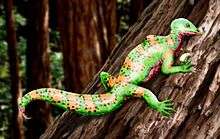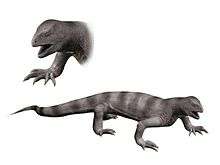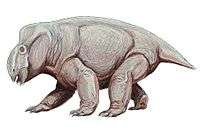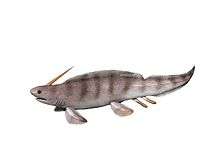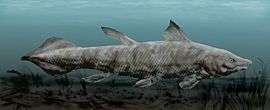Paleobiota of the Chinle Formation
Amniotes
Archosauromorphs
Crurotarsans
Other Archosauromorphs
| Misc. Archosauromorphs of the Chinle Formation | ||||||
|---|---|---|---|---|---|---|
| Genus | Species | State | Member | Abundance | Notes | Images |
| Ancistronychus[1] | A. paradoxus |
|
|
A member of Drepanosauromorpha. |
| |
| Avicranium[2] | A. renestoi |
|
|
A drepanosaur with particular surfaces of its vertebral centrae that are heterocoelous (saddle-shaped). The neural spines are anteroposteriorly short and strongly anterodorsally inclined. These features closely resemble those of Drepanosaurus. | ||
|
C. harrisae[3] |
|
|
A archosauriform represented only by teeth.[3] It is treated as indeterminate archosauriform remains by Irmis in 2005.[3] It was originally thought to be an ornithischian dinosaur. | |||
| Dolabrosaurus | D. aquatilis |
|
|
A drepanosaur. | ||
| Drepanosaurus[4] | D. unguicaudatus |
|
|
A drepanosaur. | ||
| Rugarhynchos[5] | R. sixmilensis |
|
|
A doswelliid archosauriform. Originally described as a species of Doswellia,[6] but subsequently transferred to a separate genus. | ||
|
Indeterminate[7] |
|
|
Represented by a cervical rib.[7] |
A tanystropheid represented by several hundred fossil specimens. | ||
|
T. murryi[8] |
|
|
An unknown amniote represented by scattered teeth formerly believed to be from an ornithischian dinosaur.[8] Later discoveries of similar teeth in pseudosuchians meant that these could no longer be regarded as anything more specific than some kind of archosauriform.[8] | |||
|
T. buettneri[10] |
|
|
||||
|
T. dornorum[11] |
|
|
||||
|
T. jacobsi[12] |
|
|||||
|
T. phasmalophos[13] |
|
|
||||
|
V. campi[14] |
|
A strange aquatic carnivore of uncertain affinities that is represented by both articulated skeletons and scattered elements like osteoderms and vertebrae.[14] | ||||
Other amniotes
| Misc. Amniotes of the Chinle Formation | ||||||
|---|---|---|---|---|---|---|
| Genus | Species | State | Member | Abundance | Notes | Images |
|
A. rectori[15] |
|
|
Known only from a partial skull.[15] |
A strange neodiapsid whose bones were heavily ornamented "with subtriangular knobs... running the length of the bones." Even these ornamentations were ornamented "with additional grooves." It is too bizarre to be currently classified as anything more than a probable diapsid.[15] |
| |
| Chinlechelys | C. tenertesta |
|
An early turtle. | |||
|
C. obscurus[16] |
|
|
Known only from a jaw fragment and some isolated teeth.[16] |
Originally believed to be a fish, Colognathus had distinct, fluted teeth.[16] | ||
|
K. colberti[17] |
|
Known only from two teeth.[17] |
Although they share some similarities with cynodont teeth, the known Kraterokheirodon teeth are very distinctive and can't be confidently referred to a known amniote group.[17] | |||
| Palacrodon[18] | Indeterminate |
|
A diapsid reptile of uncertain phylogenetic placement. | |||
|
P. hesternus[19] |
|
Known from several hundred remains, but very rare outside of the highly concentrated Placerias Quarry.[19] the large numbers of specimens in the Placerias Quarry attributable to "taphonomic processes."[19] |
A placeriine stahleckeriid | |||
|
U. schneideri[21] |
|
|
Known in Chinle from only a single tooth. The presence of venom channels is consistent with other known Uatchitodon specimens, although the Chinle specimen's channels are unique in being "completely enclosed under the surface of the crown."[22] |
An unknown reptile, probably a carnivorous archosauromorph. | ||
| Whitakersaurus[23] | W. bermani |
|
|
A rhynchocephalian found at Ghost Ranch. | ||
| Indeterminate procolophonid[24] | Indeterminate |
|
||||
Batrachomorphs
Color key
|
Notes Uncertain or tentative taxa are in small text; |
| Batrachomorphs of the Chinle Formation | ||||||
|---|---|---|---|---|---|---|
| Genus | Species | State | Member | Abundance | Notes | Images |
|
A. gregorii[25] |
|
Common in the Owl Rock and Petrified forest members.[25] Blue Mesa remains are fragmentary.[25] |
Junior synonym of Koskinonodon |
|||
|
C. jenkinsi |
|
A member of Stereospondyli, possibly a stem-caecilian. | ||||
|
K. perfecta[28] |
|
K. perfecta is "possibly the most common tetrapod fossil in the lower Chinle", although its presence in the upper Chinle is "unclear".[28] |
A temnospondyl. The new genus Koskinonodon was erected for the species "Buettneria" perfecta when it was discovered that the latter genus was preoccupied.[27] |
| ||
|
Indeterminate |
|
|
Might be more closely related to crown-group anurans than to Early Triassic taxa Triadobatrachus and Czatkobatrachus. | |||
Cartilaginous fish
| Chondrichthyans of the Chinle Formation | ||||||
|---|---|---|---|---|---|---|
| Genus | Species | State | Stratigraphic position | Abundance | Notes | Images |
|
Indeterminate[30] |
|
Only a single tooth is known.[30] |
| |||
|
L. humblei[32] |
|
Lonchidion remains are common throughout the Carnian microvertebrate sites of the American southwest.[32] | ||||
|
Phoebodus[33] |
Indeterminate[33] |
|
|
Only a single specimen has been recovered from the formation.[33] |
||
|
Reticulodus[34] |
R. synergus[34] |
|
The crown of its tooth bears a "reticulating ornamentation on [its] occlusal surface[.]"[34] Reticulodus remains are common throughout the Norian microvertebrate sites of the American southwest.[34] | |||
|
X. moorei[35] |
|
Common in the lower Chinle Formation's microvertebrate localities.[35] |
||||
Basal Lobe-finned fish
Coelacanths
| Actinistians of the Chinle Formation | ||||||
|---|---|---|---|---|---|---|
| Genus | Species | State | Stratigraphic position | Abundance | Notes | Images |
|
Indeterminate[37] |
|
| ||||
Lungfish
Color key
|
Notes Uncertain or tentative taxa are in small text; |
| Dipnoans of the Chinle Formation | ||||||
|---|---|---|---|---|---|---|
| Genus | Species | State | Abundance | Notes | Notes | |
|
A. dorotheae[38] |
||||||
|
Indeterminate[38] |
|
Arganodus toothplates are the most common fossil in the formation from a non-tetrapod.[38] They are evenly distributed across strata, although some individual localities have very high concentrations.[38] |
Most Chinlean Arganodus fossils are isolated tooth plates.[38] | |||
|
C. dorotheae[38] |
Named by Case in 1921, in the 1980s it was referred to Arganodus.[38] | |||||
Ray-finned fish
| Actinopterygians of the Chinle Formation | ||||||
|---|---|---|---|---|---|---|
| Genus | Species | State | Stratigraphic position | Abundance | Notes | Images |
|
Indeterminate[40] |
|
|
Known only from two vertebrae.[40] |
| ||
|
Cionichthys[41] |
C. dunklei |
|
A member of Redfieldiiformes. | |||
|
H. weiri |
|
|
A member of Dapediiformes.[42] | |||
|
L. hillsi[41] |
|
A member of Redfieldiiformes. | ||||
|
Indeterminate[44] |
|
Represented by isolated scales.[44] | ||||
|
Lophionotus[45] |
L. sanjuanensis[45] |
|
|
A member of Semionotiformes. | ||
|
L. chinleana[46] |
|
|
A member of Semionotiformes. | |||
|
Indeterminate |
|
|
A member of Saurichthyiformes. | |||
|
Synorichthys[41] |
S. stewarti |
|
A member of Redfieldiiformes. | |||
|
Tanaocrossus[41] |
T. kalliokoskii |
|
An enigmatic actinopterygian.[42] | |||
|
T. dolorensis[41] |
|
A member of Palaeonisciformes.[41] | ||||
|
Indeterminate[49] |
|
Common.[49] |
Isolated scales from Chinle microvertebrate sites commonly have Turseodus-like ridges, however that feature is not unique to Turseodus and in 2005 Irmis advised researchers to regard them as indeterminate palaeoniscid remains.[49] | |||
Footnotes
- Gabriel S. Gonçalves; Christian A. Sidor (2019). "A new drepanosauromorph, Ancistronychus paradoxus n. gen. et sp., from the Chinle Formation of Petrified Forest National Park, Arizona, USA". PaleoBios. 36: ucmp_paleobios_46203.
- Pritchard, Adam C.; Nesbitt, Sterling J. (2017-10-01). "A bird-like skull in a Triassic diapsid reptile increases heterogeneity of the morphological and phylogenetic radiation of Diapsida". Open Science. 4 (10): 170499. doi:10.1098/rsos.170499. ISSN 2054-5703. PMC 5666248. PMID 29134065.
- "Vertebrate Fauna; Archosauriformes; Crosbysaurus harrisae," Irmis (2005) p. 71
- Pritchard, Adam C.; Turner, Alan H.; Irmis, Randall B.; Nesbitt, Sterling J.; Smith, Nathan D. (2016-10-24). "Extreme Modification of the Tetrapod Forelimb in a Triassic Diapsid Reptile". Current Biology. 26 (20): 2779–2786. doi:10.1016/j.cub.2016.07.084. ISSN 0960-9822. PMID 27693141.
- Brenen M. Wynd; Sterling J. Nesbitt; Michelle R. Stocker; Andrew B. Heckert (2020). "A detailed description of Rugarhynchos sixmilensis, gen. et comb. nov. (Archosauriformes, Proterochampsia), and cranial convergence in snout elongation across stem and crown archosaurs". Journal of Vertebrate Paleontology. in press: e1748042. doi:10.1080/02724634.2019.1748042.
- Lucas, Spencer; Heckert, Andrew. "A new species of the enigmatic archosauromorph Doswellia from the Upper Triassic Bluewater Creek Formation, New Mexico, USA". Palaeontology.
- "Vertebrate Fauna; Archosauromorpha; Tanytrachelos sp.," Irmis (2005) p. 70
- "Vertebrate Fauna; Archosauriformes; Tecovasaurus murryi," Irmis (2005) p. 71
- "Vertebrate Fauna; Archosauromorpha; Trilophosaurus buettneri, Trilophosaurus jacobsi, Trilophosaurus sp." Irmis (2005) p. 70
- "Vertebrate Fauna; Archosauromorpha; Trilophosaurus buettneri," Irmis (2005) p. 70
- "Abstract," Mueller and Parker (2006) p. 119
- "Vertebrate Fauna; Archosauromorpha; Trilophosaurus jacobsi," Irmis (2005) p. 70
- Ben T. Kligman; Adam D. Marsh; Sterling J. Nesbitt; William G. Parker; Michelle R. Stocker (2020). "New trilophosaurid species demonstrates a decline in allokotosaur diversity across the Adamanian-Revueltian boundary in the Late Triassic of western North America". Palaeodiversity. 13 (1): 25–37. doi:10.18476/pale.v13.a3.
- "Vertebrate Fauna; Archosauriformes; Vancleavea campi," Irmis (2005) p. 71
- "Vertebrate Fauna; Reptilia incertae sedis; Acallosuchus rectori," Irmis (2005) pp. 69-70
- "Vertebrate Fauna; Parareptilia; Colognathus obscurus," Irmis (2005) p. 69
- "Vertebrate Fauna; Amniota incertae sedis; Kraterokheirodon colberti," Irmis (2005) p. 69
- Ben T. Kligman; Adam D. Marsh; William G. Parker (2018). "First records of diapsid Palacrodon from the Norian, Late Triassic Chinle Formation of Arizona, and their biogeographic implications". Acta Palaeontologica Polonica. 63 (1): 117–127. doi:10.4202/app.00426.2017.
- "Vertebrate Fauna; Synapsida; Placerias hesternus," Irmis (2005) p. 82
- Listed as cf. Uatchitodon sp. in "Vertebrate Fauna; Reptilia incertae sedis; Cf. Uatchitodon sp," Irmis (2005) p. 69
- Mitchell J.S., Heckert A.B., Sues H.-D. (2010). "Grooves to tubes: evolution of the venom delivery system in a Late Triassic "reptile"". Naturwissenschaften. 97 (12): 1117–1121. doi:10.1007/s00114-010-0729-0. PMID 21060984.CS1 maint: multiple names: authors list (link)
- "Vertebrate Fauna; Reptilia incertae sedis; Cf. Uatchitodon sp," Irmis (2005) p. 69
- Heckert, Andrew B.; Lucas, Spencer G.; Rinehart, Larry F.; Hunt, Adrian P. (2008-07-01). "A New Genus and Species of Sphenodontian from the Ghost Ranch Coelophysis Quarry (upper Triassic: Apachean), Rock Point Formation, New Mexico, Usa". Palaeontology. 51 (4): 827–845. doi:10.1111/j.1475-4983.2008.00786.x. ISSN 1475-4983.
- Nicholas C. Fraser; Randall B. Irmis; David K. Elliott (2005). "A procolophonid (Parareptilia) from the Owl Rock Member, Chinle Formation of Utah, USA". Palaeontologia Electronica. 8 (1): Article Number 8.1.13.
- "Vertebrate Fauna; Temnospondyli; Apachesaurus gregorii" Irmis (2005) pp. 67-68
- Jason D. Pardo; Bryan J. Small; Adam K. Huttenlocker (2017). "Stem caecilian from the Triassic of Colorado sheds light on the origins of Lissamphibia". Proceedings of the National Academy of Sciences of the United States of America. 114 (27): E5389–E5395. doi:10.1073/pnas.1706752114. PMC 5502650. PMID 28630337.
- Mueller (2007)
- "Vertebrate Fauna; Temnospondyli; Buettneria perfecta" Irmis (2005) p. 67. Note that Koskinonodon was listed under the preoccupied (see Mueller 2007) name Buettneria in the preceding reference.
- Michelle R. Stocker; Sterling J. Nesbitt; Ben T. Kligman; Daniel J. Paluh; Adam D. Marsh; David C. Blackburn; William G. Parker (2019). "The earliest equatorial record of frogs from the Late Triassic of Arizona". Biology Letters. 15 (2): Article ID 20180922. doi:10.1098/rsbl.2018.0922. hdl:10919/87931. PMC 6405462. PMID 30958136.
- "Vertebrate Fauna; Chondrichthyes; Acrodus sp." Irmis (2005) p. 65
- The Petrified Forest and Sonsela Acrodus specimens are actually Reticulodus. See "Vertebrate Fauna; Chondrichthyes; Acrodus sp." Irmis (2005) p. 65 for details.
- "Vertebrate Fauna; Chondrichthyes; Lonchidion humblei," Irmis (2005) p. 65
- "Vertebrate Fauna; Chondrichthyes; Phoebodus sp." Irmis (2005) p. 65
- "Vertebrate Fauna; Chondrichthyes; Reticulodus synergus," Irmis (2005) p. 65
- "Vertebrate Fauna; Chondrichthyes; 'Xenacanthus' moorei," Irmis (2005) p. 64
- Listed as cf. Chinlea sp. in "Vertebrate Fauna; Temnospondyli; Cf. Chinlea sp." Irmis (2005) p. 67
- "Vertebrate Fauna; Temnospondyli; Cf. Chinlea sp." Irmis (2005) p. 67
- "Vertebrate Fauna; Temnospondyli; Arganodus sp." Irmis (2005) p. 67
- Listed as "cf. Australosomus" in "Vertebrate Fauna; Osteichthyes; Cf. Australosomus sp." Irmis (2005) p. 66-67
- "Vertebrate Fauna; Osteichthyes; Cf. Australosomus sp." Irmis (2005) p. 66-67
- Bobb Schaeffer (1967). "Late Triassic fishes from the western United States". Bulletin of the American Museum of Natural History. 135: 285–342. hdl:2246/1125.
- Sarah Z. Gibson (2016). "Redescription and Phylogenetic Placement of †Hemicalypterus weiri Schaeffer, 1967 (Actinopterygii, Neopterygii) from the Triassic Chinle Formation, Southwestern United States: New Insights into Morphology, Ecological Niche, and Phylogeny". PLoS ONE. 11 (9): e0163657. doi:10.1371/journal.pone.0163657. PMC 5033578. PMID 27657923.
- Listed as "cf. Lasalichthyes" in "Vertebrate Fauna; Osteichthyes; Cf. Lasalichthyes sp." Irmis (2005) p. 66
- "Vertebrate Fauna; Osteichthyes; Cf. Lasalichthyes sp." Irmis (2005) p. 66
- Sarah Z. Gibson (2013). "A new hump-backed ginglymodian fish (Neopterygii, Semionotiformes) from the Upper Triassic Chinle Formation of southeastern Utah". Journal of Vertebrate Paleontology. 33 (5): 1037–1050. doi:10.1080/02724634.2013.758125.
- Sarah Z. Gibson (2013). "Biodiversity and Evolutionary History of †Lophionotus (Neopterygii: †Semionotiformes) from the Western United States". Copeia. 2013 (4): 582–603. doi:10.1643/CI-12-028.
- Ben T. Kligman; William G. Parker; Adam D. Marsh (2017). "First record of Saurichthys (Actinopterygii) from the Upper Triassic (Chinle Formation, Norian) of western North America". Journal of Vertebrate Paleontology. 37 (5): e1367304. doi:10.1080/02724634.2017.1367304.
- Listed as "cf. Turseodus" in "Vertebrate Fauna; Osteichthyes; Cf. Turseodus sp." Irmis (2005) p. 66
- "Vertebrate Fauna; Osteichthyes; Cf. Turseodus sp." Irmis (2005) p. 66
References
- Irmis, R. B. 2005. The vertebrate fauna of the Upper Triassic Chinle Formation in northern Arizona. p. 63-88. in S.J. Nesbitt, W.G. Parker, and R.B. Irmis (eds.) 2005. Guidebook to the Triassic formations of the Colorado Plateau in northern Arizona: Geology, Paleontology, and History. Mesa Southwest Museum Bulletin 9.
- Mueller, B. D. and Parker, W. G. 2006. A new species of Trilophosaurus (Diapsida: Archosauromorpha) from the Sonsela Member (Chinle Formation) of Petrified Forest National Park, Arizona. In W. G. Parker, S. R. Ash & R. B. Irmis (eds.), A Century of Research at Petrified Forest National Park, 1906-2006: Geology and Paleontology. Museum of Northern Arizona Bulletin 62:119-125
- Mueller, B.D. (2007). "Koskinonodon Branson and Mehl, 1929, a replacement name for the preoccupied temnospondyl Buettneria Case, 1922". Journal of Vertebrate Paleontology. 27 (1): 225. doi:10.1671/0272-4634(2007)27[225:KBAMAR]2.0.CO;2.
- Weishampel, David B.; Dodson, Peter; and Osmólska, Halszka (eds.): The Dinosauria, 2nd, Berkeley: University of California Press. 861 pp. ISBN 0-520-24209-2.

